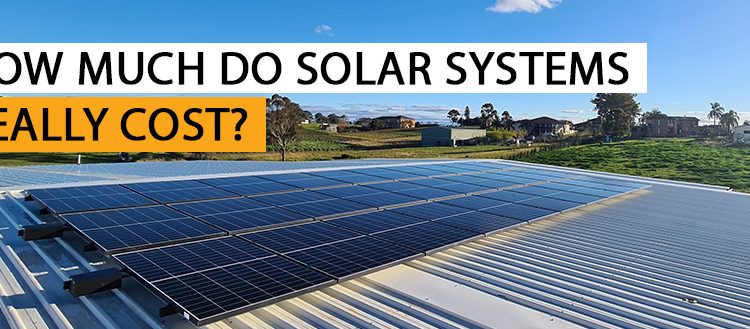How A lot Do Solar Techniques Actually Value In 2020? Solar Panel Costs Sydney
The Price of Solar Power Using Quality Solar Panels
Contents
The main factor that will determine how much you pay for solar panels is how much power you want to generate.
Solar panels output around 360W to 370W per panel, and as a general rule, a solar power system in Sydney will generate 4 times its size as a daily average. In reality, it will do a lot more than this in summer and less in winter.
Furthermore, because solar power is generated from light (not heat), your system will perform well on sunny days and may hardly work at all during dark stormy weather, especially in winter.
As an example, a 10kW solar system in Sydney will generate around 40 kWh a day as illustrated here:
The main benefit of solar power is to use solar power in the home as it is generated. This directly reduces your power bill because you are using free solar power rather than buying it from the grid.
Many people confuse the benefit of solar power with the feed-in tariff, more information on that is available here: How Solar Power Reduces Your Power Bill
To size up a solar system, you should try and work out how much power you can use during the daytime, either as an estimate or by reading your meter. By reading the number on your meter in the morning and then again in the evening, you simply subtract one number from the other to work out how many kWh your household used during the day. Divide that number by 4 to get a rough idea of the solar system you need (as a solar system generates 4 times its size on an average day).
Step 2 is to work out how much power you currently use during the evening that could be used during the daytime. Examples include setting the dishwasher on a timer to run while you are at work or perhaps turning the air conditioner on a little earlier to cool down the house before you get home from work.
Step 3 is to take into account any expected changes to your energy usage. A lot of households install an air conditioner after going solar to make the most of the free electricity. It is important to factor this into the size of your solar system.
Once you have a rough idea of how much power you need to cover, you can then look to replace this with solar power. Here are some guidelines to help you size up a solar system and the price for a good quality solar system:
- A 5kW system will generate around 14 kWh a day in winter and 25 kWh a day in summer. The price of a 5kW system is around $6,500 to $10,000 fully installed. 5kW Solar System Price…
- A 10kW system will generate around 26 kWh a day in winter and 50 kWh a day in summer. The price of a 10kW system is around $10,000 to $19,000 fully installed. 10kW Solar System Price…
The Costs Involved When Installing A Solar Power System
Aside from how many panels you need, the price of a solar system will vary significantly depending on the quality of the components:
Solar panels are designed to last decades, however, all solar panels drop off in output over time as they age. Better quality solar panels on average last longer, they provide more output and they are more reliable. They also cost more money.
We recommend going with a reliable brand such as LG Solar or Trina Solar, and we would be happy to provide pricing for different panels to help you make an informed decision.
With a 5kW system, you can expect to pay an additional $1,000 to $2,000 for top-of-the-range 360W high-efficiency panels compared with a mid-range panel. You can save some money upfront by choosing a cheap Chinese panel, however, we strongly advise against it due to a reduction in quality, performance and reliability: A Warning About Cheap Solar Systems
The Inverter. Solar panels output DC power. This needs to be converted to AC so it is compatible with your home. All solar systems come with an inverter that converts DC to AC, and because it is the working part of the system it is the component most likely to break.
For this reason, Solaray only offers the top handful of brands from companies like Enphase, SMA and Delta. A cheap inverter from China may cost $500 compared to $2000 for a European Made equivalent.
It is common for the cheaper inverters to only last a few years, whereas you can expect a good quality inverter to last 15 years or longer. Trying to cut costs on your inverter will often give you problems over the life of your system, and it isn’t always cheap booking a service job and then getting an inverter replaced that is out of warranty.
Systems powered by Enphase allow for panel-level output that can significantly increase output, especially if you have patchy shade on your roof.
Monitoring typically comes with the inverter, however, there is now a range of advanced options for households that want more functionality and control. Brands like Enphase offer consumption monitoring that allows you to keep track of how much power you are using in your home as well as how much solar power you are generating.
If you decide to add battery storage such as the Tesla Powerwall, the battery comes with advanced system monitoring and energy management. This additional functionality can turn your solar into a smart energy management system.
Battery storage is now becoming mainstream in Australia with many of our customers now integrating storage into their solar power system.
Battery storage starts at around $5000 for a small unit, up to around $13,000 for the larger systems that come with incredibly smart energy management. Battery storage allows your household to run on solar 24/7, and you can choose backup functionality for emergency power when the grid goes down. The battery can even recharge the next morning when the sun comes up. The future of renewable energy has already arrived!
Additional Costs of Installing Solar Panels
Split Arrays: Solar power is typically generated across the day with the output looking like a bell curve. By splitting your array across two roof sections, you can spread the output across the day and have two smaller peaks of output that can then be easier to manage. Installing two arrays of panels typically costs around $150-$300 for the additional hardware such as DC isolators and cabling plus the additional labour cost. We recommend a split array for many of our customers.
Meter Board Work: When you have solar installed, your meter board must be left up to current Australian standards. If you have an old meter board that needs upgrading, this must be done when installing solar power.
Typically, the work will cost less than $100 for things such as a new mains switch or a new service fuse. If your meter board is too high ( such as on heritage era buildings in the inner-west of Sydney), moving a meter board can cost around $700-$1000 or so depending on what needs to be done, and so it is often a show stopper unless you want the meter board upgraded as an aside from the new solar system. Please talk to us for more information if you think your meter board needs upgrading, we’d be happy to help with a quote if you send us a photo of your board.
Access to a high roof may require hiring a cherry picker. Most houses will be fine, however, from time to time we need to install solar power on roofs that can’t be accessed with a ladder. Hiring a cherry picker isn’t cheap, however, it’s not always a show stopper. If you have a high roof or you are concerned we won’t be able to access your roof, please call the Solaray Team on 1300 221 586 so that we can make an assessment for you.
Metering: When you install solar power you need to replace your electricity meter with a bi-directional digital meter that measures how much power you are sending back to the grid. If you have a digital meter, it will most likely need to be replaced by your retailer with a similar model but one that has a different program in it. Most energy retailers in NSW are now offering to change your meter free of charge.
Alternatively, we can arrange to organise a no-cost meter change should you choose to switch to Energy Locals as your energy retailer. The Energy Locals plan includes a solar feed-in-tariff of up to 10 cents (including GST), competitive prices on electricity, carbon offsets for all your energy use, and no exit fees or lock-in contracts. More information on Energy Locals
What You Pay For With A Quality Installation
Again, please talk to us for more information on the technical side of an installation. We can take care off all the paperwork and technical details, making the process of going solar smooth and easy.


